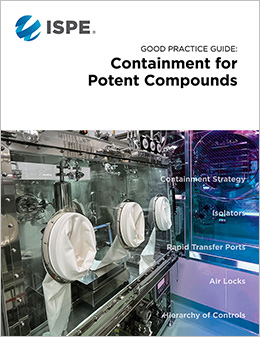Good Practice Guide: Containment for Potent Compounds

Published: December 2022
Pages: 258
There are an increasing number of highly potent compounds handled within the pharmaceutical industry, a trend that has continued for over 20 years to the point where most modern products require some degree of containment or other exposure control to maintain safety.
The ISPE Good Practice Guide: Containment for Potent Compounds covers all aspects of pharmaceutical containment including background to safe working levels and the mechanisms of exposure and how such exposure can be controlled. There are chapters on typically applied approaches used in containing exposure for commonly applied process systems across all elements of pharmaceutical development and manufacturing.
Developed by a multinational team of experts consisting of engineers, toxicologists, hygienists, and analysts from major pharmaceutical companies and suppliers, this Guide aims to consolidate this widely dispersed knowledge base into one document. It describes and discusses the containment methodologies, processes, and technologies commonly used in the pharmaceutical industry when handling potent compounds.
The Guide contains numerous photos on the wide range of technologies presented, such as isolators, process interfaces and transfer ports, air locks, filtration systems, containment performance assessments, and cleaning/waste treatment. Additional topics include GMP aspects, containment systems’ lifecycle, unplanned emission/spillage recovery procedures, and the development of a containment strategy.
Available in Japanese | |
| ISPE Good Practice Guide: Containment for Potent Compounds | |
 | Individual Download Member Price Non-member Price |
Guide Core Team
Emerging Economy Publication Discount
ISPE members located in nations with emerging economies* are eligible for a 50% discount on publications from the regular member price. To receive the discount, members must be logged in with their ISPE member account. Contact Member Services at ask@ispe.org for more information or if you have questions about your membership status or this discount program. Discounts do not apply to Accuris (formerly Techstreet) document downloads.
*Based on the World Bank's system for classifying national economies by GNI per capita. Includes low-income, lower middle-income, and upper middle-income economies. To learn more about the World Bank classification system, please click here. Currently includes the following nations, except where international sanctions apply:
- Afghanistan
- Albania
- Algeria
- Angola
- Argentina
- Armenia
- Azerbaijan
- Bangladesh
- Belarus
- Belize
- Benin
- Bhutan
- Bolivia
- Bosnia and Herzegovina
- Botswana
- Brazil
- Bulgaria
- Burkina Faso
- Burundi
- Cabo Verde
- Cambodia
- Cameroon
- Central African Republic
- Chad
- China
- Colombia
- Comoros
- Congo, Dem. Rep.
- Congo, Rep.
- Costa Rica
- Côte d’Ivoire
- Cuba
- Djibouti
- Dominica
- Dominican Republic
- Ecuador
- Egypt, Arab Rep.
- El Salvador
- Equatorial Guinea
- Eritrea
- Eswatini
- Ethiopia
- Fiji
- Gabon
- Gambia, The
- Georgia
- Ghana
- Grenada
- Guatemala
- Guinea
- Guinea-Bissau
- Haiti
- Honduras
- India
- Indonesia
- Iran, Islamic Rep.
- Iraq
- Jamaica
- Jordan
- Kazakhstan
- Kenya
- Kiribati
- Korea, Dem. People's Rep.
- Kosovo
- Kyrgyz Republic
- Lao PDR
- Lebanon
- Lesotho
- Liberia
- Libya
- Madagascar
- Malawi
- Malaysia
- Maldives
- Mali
- Marshall Islands
- Mauritania
- Mauritius
- Mexico
- Micronesia, Fed. Sts.
- Moldova
- Mongolia
- Montenegro
- Morocco
- Mozambique
- Myanmar
- Namibia
- Nepal
- Nicaragua
- Niger
- Nigeria
- North Macedonia
- Pakistan
- Palau
- Papua New Guinea
- Paraguay
- Peru
- Philippines
- Russian Federation
- Rwanda
- Samoa
- São Tomé and Príncipe
- Senegal
- Serbia
- Sierra Leone
- Solomon Islands
- Somalia
- South Africa
- South Sudan
- Sri Lanka
- St. Lucia
- St. Vincent and the Grenadines
- Sudan
- Suriname
- Syrian Arab Republic
- Tajikistan
- Tanzania
- Thailand
- Timor-Leste
- Togo
- Tonga
- Tunisia
- Türkiye
- Turkmenistan
- Tuvalu
- Uganda
- Ukraine
- Uzbekistan
- Vanuatu
- Vietnam
- West Bank and Gaza
- Yemen, Rep.
- Zambia
- Zimbabwe






























